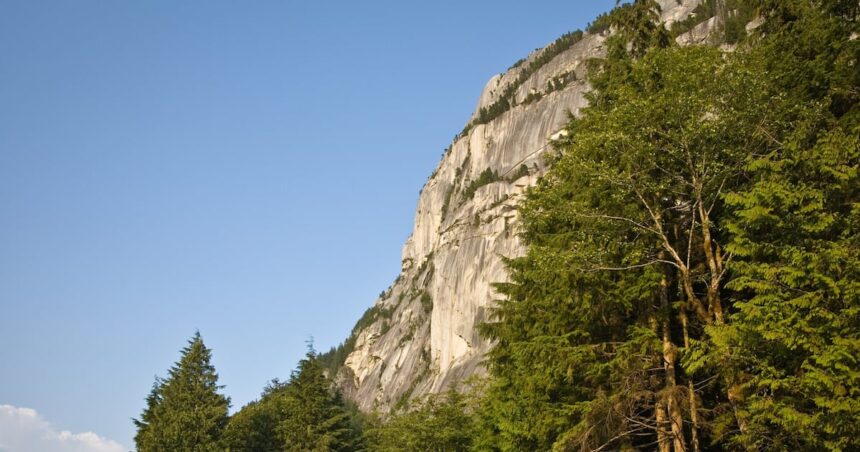A popular section of Stawamus Chief Provincial Park has been closed indefinitely after a black bear exhibiting food-conditioned behavior began approaching hikers and climbers with increasing boldness.
The closure, announced Wednesday by BC Parks officials, affects the South Peak trail area and several climbing routes, leaving outdoor enthusiasts scrambling to adjust weekend plans. Wildlife conservation officers cited multiple close encounters where the bear showed no fear of humans – a dangerous development they attribute directly to improper food storage and deliberate feeding.
“This isn’t just about one bear becoming a nuisance,” said Conservation Officer Melissa Greeley during an impromptu press briefing at the park entrance. “We’re witnessing the consequences of visitors repeatedly leaving food accessible or, worse, intentionally feeding wildlife. When bears associate humans with easy meals, the outcome is rarely good for the bear.”
The iconic granite monolith, located near Squamish about 60 kilometers north of Vancouver, attracts approximately 300,000 visitors annually. Its sheer rock faces and panoramic views of Howe Sound make it a bucket-list destination for climbers worldwide.
Local guide Simon Parcher has witnessed the bear’s increasingly concerning behavior firsthand. “Three weeks ago, it was just hanging around the campground perimeter. By last weekend, it was approaching backpacks while climbers were actively setting up routes,” he told me during a phone interview. “I’ve guided here for twelve years, and this level of habituation is particularly worrying.”
According to provincial wildlife data, conservation officers destroyed 579 black bears across British Columbia last year – many following human-wildlife conflicts that began with food conditioning. The pattern typically starts with bears finding unsecured garbage or food, escalates to regular appearances in recreational areas, and eventually leads to aggressive behavior.
The Squamish community, which has branded itself as an outdoor recreation hub, now faces difficult questions about sustainable tourism and wilderness stewardship. Local businesses anticipate economic impacts from the partial closure, especially with peak season approaching.
“We’re looking at a 20 percent drop in guided trips this weekend alone,” said Jenna Rutherford, operations manager at Summit Climbing Experiences. “But honestly, most of us support whatever measures protect both visitors and wildlife. Nobody wants to see another bear destroyed because of human carelessness.”
BC Parks officials have deployed additional staff to enforce proper food storage regulations throughout the park’s remaining open areas. Violations can result in fines up to $575 under provincial wildlife regulations.
The Ministry of Environment and Climate Change Strategy confirmed that wildlife specialists are monitoring the bear’s movements using tracking devices while considering intervention options. Relocation, though often requested by the public, has shown limited success with food-conditioned bears, who frequently return to human-use areas or create similar problems elsewhere.
“The ideal outcome would be for the bear to naturally move away from the park once food sources are properly secured,” said Dr. Karen Mitchell, wildlife biologist with the North Shore Black Bear Society. “But we’re facing the consequences of months of inappropriate human behavior. This bear’s food conditioning didn’t happen overnight.”
For disappointed visitors with existing plans, park officials recommend nearby alternatives including parts of Garibaldi Provincial Park and Shannon Falls, though they caution that proper wildlife awareness practices remain essential throughout the region.
While waiting for updates on the situation, the community conservation center in Squamish has expanded its “Bear Smart” education programming, with volunteers distributing information at trailheads and campgrounds throughout the Sea to Sky corridor.
“This closure represents exactly what we’ve been warning about,” said Robert Wilkinson, who coordinates the volunteer program. “When we fail to respect wildlife boundaries, everyone loses – the public loses access, businesses lose customers, and too often, the bears lose their lives.”
The timing couldn’t be worse for area businesses already rebounding from pandemic-related setbacks. The popular granite dome typically sees its highest visitation during late spring and summer months when climbing conditions are optimal.
Provincial officials have not provided an estimated reopening timeline, stating only that wildlife specialists will continue monitoring the situation daily. The bear’s behavior following the closure and food source removal will ultimately determine next steps.
For now, the situation serves as a powerful reminder that our wilderness experiences come with responsibilities – not just for our own safety, but for the wildlife whose habitat we share. As one local climbing guide put it: “The Chief has been here for millennia. If we want to keep enjoying it, we need to do better as visitors.”






